The AFC’s underachievement kingpins for much of this century, the Chargers saw their most recent mission hit a wall last season. After GM Tom Telesco gave Brandon Staley another year in the wake of the 2022 team’s historic collapse, both ended up gone less than a year later. In terms of pure GMs, no AFC front office boss had been in place longer than Telesco. The Bolts responded by changing their managerial structure; their decision-making hierarchy now runs through a head coach.
Jim Harbaugh will be tasked with maximizing Justin Herbert in a way Staley and Anthony Lynn could not, and the Chargers stripped away their quarterback’s long-running receiving corps. Harbaugh’s pedigree aside, many questions come out of this Bolts offseason. But the team, after years of adding first-time HCs on lower-cost contracts, veered in a different direction as the Telesco era failed to turn steady offseason hype into much of consequence.
Coaching/Front Office:
- Hired Jim Harbaugh as head coach
- Brought in Joe Hortiz as general manager, Chad Alexander as assistant GM
- Michigan DC Jesse Minter followed Harbaugh to work in same capacity
- Signed off on Greg Roman OC hire, reunited with Shane Day as QBs coach
- Hired NaVorro Bowman as LBs coach
- Added Marc Trestman, Nick Hardwick, Rick Minter to coaching staff
Weeks before the Chargers fired Staley, Harbaugh connections began. While the team was also tied to Lions OC Ben Johnson early in the process and later linked loosely to Bill Belichick, Harbaugh buzz persisted. Chargers ownership contacted Harbaugh’s camp upon firing Staley, laying the groundwork for a bolder Bolts hire.
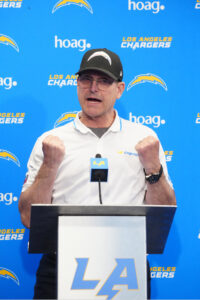 The embattled yet successful Michigan leader, whom the Wolverines sought to extend following a two-suspension season that ended with the program’s first national championship in 26 years, maximized his leverage by negotiating with the Big Ten school and scheduling a second Falcons interview. Harbaugh never made it to Atlanta for that meeting, viewing the Los Angeles gig as enticing enough to make his long-rumored jump back to the NFL.
The embattled yet successful Michigan leader, whom the Wolverines sought to extend following a two-suspension season that ended with the program’s first national championship in 26 years, maximized his leverage by negotiating with the Big Ten school and scheduling a second Falcons interview. Harbaugh never made it to Atlanta for that meeting, viewing the Los Angeles gig as enticing enough to make his long-rumored jump back to the NFL.
On paper, Harbaugh’s NFL exit qualified as odd. The former quarterback immediately turned around the 49ers upon arrival in 2011, guiding them to three straight NFC championship games. The 2011 and ’13 San Francisco squads fell just short of NFC championships while the ’12 team saw a still-debated non-whistle in the final seconds of Super Bowl XLVII cement a victory for Harbaugh’s older brother. Even after an 8-8 2014 season, Harbaugh enters the 2024 campaign in fifth place in all-time win percentage. For coaches who began their careers after the 1970 merger, no one outflanks Harbaugh’s .695 mark.
A power struggle with then-49ers GM Trent Baalke played the lead role in Harbaugh returning to his alma mater in 2015, but the early 2020s brought steady Harbaugh-to-NFL rumors. The fiery HC had said unfinished business remained in the pros, but interviews with the Vikings (2022) and Broncos (’23) did not provide a gateway back. Rumblings in front office circles pegged Harbaugh as difficult to work with, and while that may be accurate, the veteran leader has won everywhere he has camped.
Harbaugh, 60, guided Michigan to three straight CFP fields to continue a trend of turnarounds. The former Chargers starting QB rebuilt the Stanford program and then the 49ers. Nearly 15 years after his Andrew Luck partnership ended, Harbaugh made the jump to work with a comparable QB talent.
While the Chargers have not taken heat on a Bengals level for frugality, the perception they were not willing to go big for a high-profile head coach prompted an ownership message of reimagining the football operation upon canning Telesco and Staley. The Chargers had not hired anyone with prior HC experience since replacing Marty Schottenheimer with Norv Turner in 2007. In the years since, the Bolts paid first-timers Mike McCoy, Lynn and Staley lower salaries. Harbaugh will command a $16MM-per-year salary. While that fell short of his $18MM ask, it is believed — as HC salaries do not have to be disclosed — it places him near the top of the league.
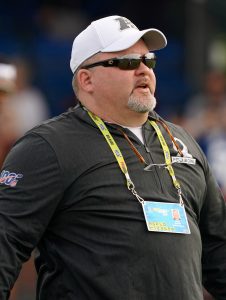 Considering Harbaugh’s past with Baalke, it certainly made sense for the Chargers to pair him with a pre-approved GM. Interviewing Giants assistant GM Brandon Brown twice, the Chargers used a John Harbaugh connection to find their Telesco successor. Hortiz will not hold final say like Telesco did, but the longtime Ravens exec has worked with the elder Harbaugh throughout the HC’s time in Baltimore.
Considering Harbaugh’s past with Baalke, it certainly made sense for the Chargers to pair him with a pre-approved GM. Interviewing Giants assistant GM Brandon Brown twice, the Chargers used a John Harbaugh connection to find their Telesco successor. Hortiz will not hold final say like Telesco did, but the longtime Ravens exec has worked with the elder Harbaugh throughout the HC’s time in Baltimore.
Hortiz, 48, served under Ozzie Newsome for 20 years and moved from the scouting level to college scouting director to director of player personnel with the Ravens. The team bumped Hortiz to the latter post in 2019, upon promoting Eric DeCosta to succeed Newsome. Hortiz has interviewed for GM jobs in the past, meeting about the Cardinals position last year and discussing the Giants and Steelers’ vacancies in 2022. Hortiz’s past with John Harbaugh, however, should give this partnership a better shot at succeeding in the long term compared to the Baalke-Jim Harbaugh pairing.
Although Alexander comes from the Jets, the former Joe Douglas lieutenant spent extensive time in Baltimore — alongside Douglas — leading up to his New York move. Hortiz hired a former coworker to be his second-in-command; Harbaugh did as well. Roman was Jim’s OC in all four years in San Francisco. The run-oriented OC — though, Roman has not spent much time with pass-first QBs — becomes a rare fourth-time NFL coordinator, having made stops in Buffalo and Baltimore since Harbaugh’s San Francisco exit.
The Ravens fired Roman after four seasons; he spent 2023 out of football. His Chargers fit will be fascinating, and it certainly appears — through the team’s actions in March and April — the Bolts will make the ground game a bigger part of their plan. It will be interesting to see how Roman tailors his style to Herbert, whose skills differ from the likes of Lamar Jackson, Tyrod Taylor and Colin Kaepernick. Roman last worked with a true pass-based signal-caller in 2012, when the 49ers made the midseason switch from Alex Smith to Kaepernick.
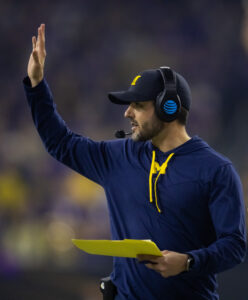 Harbaugh and Roman resurrected Smith’s career, and the future Chiefs starter carried a 70.2% completion rate at 8.0 yards per attempt when a concussion led to his 2012 benching. Roman was at the controls for Jackson’s dominant 2019 season, which brought a unanimous MVP, though his run-centric style wore thin as his Maryland stay progressed. Although Herbert is capable on the ground, Roman’s past will certainly make fantasy drafters uneasy about how he will proceed with one of the NFL’s most talented passers — especially given the team’s actions at wide receiver this offseason.
Harbaugh and Roman resurrected Smith’s career, and the future Chiefs starter carried a 70.2% completion rate at 8.0 yards per attempt when a concussion led to his 2012 benching. Roman was at the controls for Jackson’s dominant 2019 season, which brought a unanimous MVP, though his run-centric style wore thin as his Maryland stay progressed. Although Herbert is capable on the ground, Roman’s past will certainly make fantasy drafters uneasy about how he will proceed with one of the NFL’s most talented passers — especially given the team’s actions at wide receiver this offseason.
Minter, 41, checks both boxes when it comes to the Harbaughs. Like Mike Macdonald, the new Chargers DC worked under John Harbaugh (2017-20) and then Jim; Minter succeeded Macdonald as the Wolverines’ defensive play-caller in 2022. Minter made a significant jump, moving from Vanderbilt safeties coach to Michigan DC. The Big Ten power led Division I-FBS in scoring defense last season (10.4 points per game), and the Wolverines’ 268 yards allowed per game from 2022-23 ranked second.
Previously serving as Ravens DBs coach in the NFL, Minter will see his rise continue with this L.A. gig.
Trades:
- Dealt WR Keenan Allen to Bears in exchange for 2024 fourth-round pick
Shortly after Harbaugh’s hire, Allen said he expected to remain with the Chargers. The team released Mike Williams to reach cap compliance by the March 13 deadline, but a day later, it bid farewell to one of the best players in franchise history. Given where WR prices have gone this offseason, Chicago having Allen tied to a mid-second-tier contract — he is due $18.1MM in 2024, the final season of a $20MM-AAV deal. The 11-year Charger’s departure may be difficult for the Bolts in the short term, as they depended on the high-end route runner for years.
 A 2013 third-round pick, Allen had been the team’s longest-tenured player for years. While unlikely to join Lance Alworth in the Hall of Fame and landing a bit south of where John Jefferson was at his early-career peak, Allen is probably the best Bolts receiver of the past 35 years. His 904 receptions and 10,530 yards rank second — by a wide margin — in Bolts history.
A 2013 third-round pick, Allen had been the team’s longest-tenured player for years. While unlikely to join Lance Alworth in the Hall of Fame and landing a bit south of where John Jefferson was at his early-career peak, Allen is probably the best Bolts receiver of the past 35 years. His 904 receptions and 10,530 yards rank second — by a wide margin — in Bolts history.
As Antonio Gates declined, the Chargers centered their aerial attacks around Allen. The Cal alum delivered six 1,000-yard seasons, including a 1,243-yard showing in just 13 games last season. With Allen poised to help Caleb Williams‘ NFL transition, no comparable option remains on the Chargers’ roster.
The Chargers restructured Allen’s contract to create cap space last year, leading to an $11.6MM dead money charge for 2024. The team offered Allen an extension, but it appeared — per Allen’s camp — it came at a reduced rate, with the 32-year-old receiver’s agent indicating the Bolts’ one proposal included pay cuts in 2025 and 2026. As could be expected given his 2023 season and the exploding wideout market, Allen emphatically refused a pay cut.
Extensions and restructures:
- Reached pay-cut agreements to retain OLBs Joey Bosa, Khalil Mack
- Restructured C Corey Linsley‘s contract, creating $10.29MM in cap space
The restructures from Telesco’s final offseason in charge left Bosa, Mack, Allen and Williams all with cap hits of at least $32MM. The Chargers cut ties with their longtime receiving tandem but held onto their standout edge rushers, who accepted pay cuts to stay in Harbaugh’s first season. Assembled in 2022 upon the Chargers acquiring Mack from the Bears, this pair may well be going into its final season together. Mack’s Bears-built contract expires after the 2024 season.
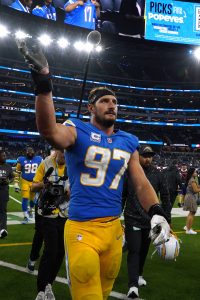 Going into his age-29 season, Bosa has seen injuries limit him significantly. This trend brought 20 absences over the past two seasons, making it a natural consideration for the Chargers to approach him about a pay cut. The talented OLB was attached to a $27MM-per-year contract, which still stood as a top-five number among edge defenders entering the offseason. Bosa, who has four Pro Bowls on his resume, is now on a two-year, $40.4MM deal.
Going into his age-29 season, Bosa has seen injuries limit him significantly. This trend brought 20 absences over the past two seasons, making it a natural consideration for the Chargers to approach him about a pay cut. The talented OLB was attached to a $27MM-per-year contract, which still stood as a top-five number among edge defenders entering the offseason. Bosa, who has four Pro Bowls on his resume, is now on a two-year, $40.4MM deal.
The March adjustment reduced Bosa’s cap number from $36.6MM to $26.1MM. No guaranteed money is due beyond 2024, giving the Chargers flexibility. If the team was to move on in 2025, at least $25MM in cap savings would emerge.
Mack’s 2018 Bears extension helped set the table for Bosa’s 2020 windfall, and while the older Bolts pass rusher was coming off a season-ending foot injury upon arriving in L.A., he has stayed healthy since. Now an eight-time Pro Bowler, Mack delivered a six-sack showing in Week 1 and rocketed back toward the top tier at his position by finishing with a career-high 17. Mack’s 22 QB hits were his most since his 2017 Raiders finale.
Mack, 33, has been a vital Bolts piece during a period spent largely without Bosa. Mack’s restructure lowered his 2024 cap hit from $38.5MM to $25.4MM. Harbaugh’s pledge this Chargers iteration can contend helped convince Bosa and Mack to stay, and the team will count on its veteran OLB pieces for at least one more season. Mack signing a six-year extension in 2018 undoubtedly will block him from a monster third contract, but the former Defensive Player of the Year has already done quite well in his career. The 2014 draftee has surpassed $150MM in career earnings.
Free agency additions:
- Gus Edwards, RB. Two years, $6.5MM ($3.38MM guaranteed)
- Bud Dupree, OLB. One year, $3MM ($2.75MM guaranteed)
- Kristian Fulton, CB. One year, $3.13MM ($2.45MM guaranteed)
- DJ Chark, WR. One year, $3MM ($2.1MM guaranteed)
- Denzel Perryman, LB. One year, $2.3MM ($1.88MM guaranteed)
- Will Dissly, TE. Three years, $14MM ($1MM guaranteed)
- Troy Dye, S. One year, $1.79MM ($665K guaranteed)
- Poona Ford, DT. One year, $1.79MM ($665K guaranteed)
- J.K. Dobbins, RB. One year, $1.61MM ($50K guaranteed)
- Tony Jefferson, S. One year, $1.21MM
- Bradley Bozeman, C. One year, $1.13MM
- Jesper Horsted, TE. One year, $1.13MM
- Hayden Hurst, TE. One year, $1.13MM
- Alex Leatherwood, OL. One year, $985K
A Saquon Barkley tie did emerge, but the Chargers — their increased interest in the run game notwithstanding — were never expected to spend big here post-Austin Ekeler. They ended up doubling down on familiarity, bringing in both of the top RBs from Roman’s Ravens years.
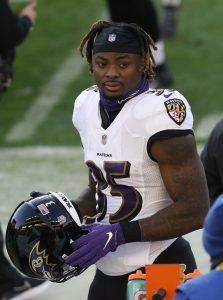 Both Dobbins and Edwards were available at low rates, the former especially, due to injury trouble. Dobbins missed all of the 2021 season and much of the 2022 campaign due to an ACL tear, and he suffered a torn Achilles — historically, a tougher injury for running backs to surmount — in Week 1 of last season.
Both Dobbins and Edwards were available at low rates, the former especially, due to injury trouble. Dobbins missed all of the 2021 season and much of the 2022 campaign due to an ACL tear, and he suffered a torn Achilles — historically, a tougher injury for running backs to surmount — in Week 1 of last season.
Dobbins displayed quality skills with a standout rookie year, when he averaged six yards per carry on 135 totes. Since the merger, only six other RBs (Mercury Morris, Jamaal Charles, Barry Sanders, O.J. Simpson, Adrian Peterson and C.J. Spiller) have averaged six yards per handoff on at least 130 carries. Upside exists, but Dobbins (43 missed games) is running out of time to show he can hold up in the NFL.
Also tearing an ACL in August 2021, Edwards joined Dobbins in missing time into the 2022 season. Edwards had shown he could hold up over an extended period, working as a complementary back — and eclipsing five yards per carry each year from 2018-20 — as Jackson became a franchise QB. The Ravens rewarded Edwards with a two-year, $9MM extension in 2021. Edwards did not play on that deal until late October 2022. Edwards’ post-injury work, however, earned him some guarantees Dobbins could not secure.
The Ravens depended on Edwards last season, having lost Dobbins and then speedy rookie Keaton Mitchell to season-ending maladies. Edwards, 29, saw his yards per carry drop to 4.1, but he led the AFC’s top-seeded team in rushing (810 yards) and scored 13 touchdowns. Particularly effective near the goal line, Edwards finished with a mid-pack 51 rushing yards over expected in 2023. The Chargers struggled to find an Ekeler backup for years, despite the perception RBs are easily replaceable. The team will bank on familiarity, though it was interesting to see the club sign off on two backs with major injuries in their recent pasts.
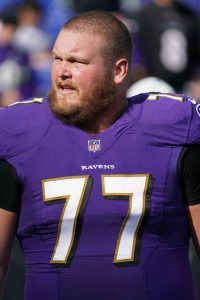 Carolina cut Bozeman, removing a $6MM-per-year contract from the payroll. The Chargers have three first-round picks and Trey Pipkins‘ midlevel deal up front; they will count on Bozeman bouncing back at a basement-level rate. Continuing a theme of Roman familiarity, Bozeman’s Ravens run (2018-21) overlapped entirely with Roman’s. Bozeman started 49 games — all but one of those coming with Roman as OC — at center and guard with Baltimore.
Carolina cut Bozeman, removing a $6MM-per-year contract from the payroll. The Chargers have three first-round picks and Trey Pipkins‘ midlevel deal up front; they will count on Bozeman bouncing back at a basement-level rate. Continuing a theme of Roman familiarity, Bozeman’s Ravens run (2018-21) overlapped entirely with Roman’s. Bozeman started 49 games — all but one of those coming with Roman as OC — at center and guard with Baltimore.
On a one-year Panthers deal in 2022, Bozeman ranked sixth in pass block win rate. Pro Football Focus graded Bozeman 21st at center last year but slotted him highest (11th) during his final Ravens season, when the former sixth-round pick converted to center after two years at guard. The Chargers did not re-sign their primary 2023 center, Will Clapp, leaving Bozeman a clear path to another gig as a starter in his age-30 season.
The Chargers passed on Malik Nabers and Rome Odunze in the draft, and while they reduced costs considerably at wide receiver, the team did bring in some help. After hosting Tyler Boyd, the team signed Chark. The Bolts also brought in Marquez Valdes-Scantling for a subsequent visit, signaling they might not be done receiver shopping. For now, however, Chark represents the only veteran piece acquired. He will join contract-year target Josh Palmer and 2023 first-rounder Quentin Johnston as veteran Chargers WRs.
 Harbaugh’s 49ers investments at receiver provided a blueprint for what Chargers fans could expect this offseason. Although those 49ers teams rostered Michael Crabtree, he was there when Harbaugh arrived. The team traded a sixth-round pick for Anquan Boldin and gave Randy Moss, Mario Manningham and Brandon Lloyd low-cost deals. This year’s Bolts are taking this route.
Harbaugh’s 49ers investments at receiver provided a blueprint for what Chargers fans could expect this offseason. Although those 49ers teams rostered Michael Crabtree, he was there when Harbaugh arrived. The team traded a sixth-round pick for Anquan Boldin and gave Randy Moss, Mario Manningham and Brandon Lloyd low-cost deals. This year’s Bolts are taking this route.
Chark, 27, is now on a fourth team in four seasons. This contract also marks the second straight year Chark will see a salary reduction. He signed a $10MM Lions deal in 2022 and a $5MM Panthers pact in ’23. A sporadically effective deep threat, the former Jaguars second-rounder did amass 525 yards in 15 games — his healthiest season since 2020 — and averaged at least 15 yards per catch in 2022 and ’23. With Herbert now set to target Chark, the 6-foot-3 weapon looms as an interesting wild card.
A down Fulton season tanked his market. The multiyear Titans starter still received interest, but given where his Chargers talks ended, it is highly unlikely his reported offers from the Broncos, Bengals and Cardinals were too notable.
Fulton missed time due to a benching as well as a stint on IR. After viewing Fulton as a midlevel corner during his 2021 and ’22 seasons as a starter, PFF slotted him as a bottom-10 option last season. He allowed a whopping 75.5% completion rate and a 114.1 passer rating as the closest defender, numbers way up from his prior two years. A starter for the Titans team that secured the AFC’s No. 1 seed in 2021, Fulton will look to bounce back under Minter in California.
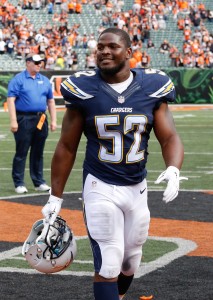 Dupree struggled with the Titans but received interest from two of his former teams — the Falcons and Steelers — this offseason. Dupree tied for the Atlanta lead with 6.5 sacks last season, though he opted for what looks like a situational role in L.A. Dupree did his best work with the Steelers, finishing a six-season run with 11.5- and eight-sack seasons; the latter came in an injury-shortened 2020 season. Now 31, the former first-rounder gives the Bolts a formidable two-deep at OLB, with second-rounder Tuli Tuipulotu flashing alongside Mack as a rookie.
Dupree struggled with the Titans but received interest from two of his former teams — the Falcons and Steelers — this offseason. Dupree tied for the Atlanta lead with 6.5 sacks last season, though he opted for what looks like a situational role in L.A. Dupree did his best work with the Steelers, finishing a six-season run with 11.5- and eight-sack seasons; the latter came in an injury-shortened 2020 season. Now 31, the former first-rounder gives the Bolts a formidable two-deep at OLB, with second-rounder Tuli Tuipulotu flashing alongside Mack as a rookie.
Drafted in Round 2 while the Chargers were still in San Diego, Perryman returns after three seasons away. The off-ball linebacker has been unable to secure favorable terms since his two-year, $12MM Chargers deal came to pass in 2019. The 2015 draftee, however, has remained too good to bench in the years since. Perryman, 31, played regular roles in Las Vegas and Houston. The Miami alum’s past two seasons did not match a 154-tackle 2021 campaign, but like Dupree, he offers a low-cost solution for a Chargers team in transition at linebacker.
Re-signings:
- Alohi Gilman, S. Two years, $10.13MM ($5.63MM guaranteed)
- Easton Stick, QB. One year, $2.67MM ($1.41MM guaranteed)
The Chargers only looked to the UDFA ranks to add a QB this offseason, keeping Stick at the QB2 spot on the depth chart after his first run of NFL work. The North Dakota State starter between Carson Wentz and Trey Lance, Stick replaced Herbert after his season-ending thumb injury. The Bolts lost each of Stick’s four starts, including a 63-21 demolition that spelled the end for Telesco and Staley, and he closed the season with a 63.8% completion rate (6.5 Y/A). It is interesting the Harbaugh-Hortiz pair did not do more than add a Division II UDFA (Casey Bauman), sticking with a Telesco-era backup. Though, the QB that defeated Harbaugh’s Wolverines in the 2022 CFP semifinal — TCU’s Max Duggan — remains on the roster.
Notable losses:
- Essang Bassey, CB
- Will Clapp, OL
- Michael Davis, CB
- Austin Ekeler, RB
- Alex Erickson, WR
- Gerald Everett, TE
- Will Grier, QB
- Jalen Guyton, WR
- Jaylinn Hawkins, S
- Justin Hollins, OLB
- Austin Johnson, DL
- Joshua Kelley, RB
- Eric Kendricks, LB (released)
- Corey Linsley, C (released)
- Dean Marlowe, S
- Kenneth Murray, LB
- Tanner Muse, LB
- Nick Vannett, TE
- Mike Williams, WR (released)
- Nick Williams, DL
Two cornerstones of the Telesco era are now on the east coast, with Ekeler and Williams respectively joining the Commanders and Jets. Both skill-position bastions were central figures in the Bolts’ Herbert- and Philip Rivers-centered offenses. While Williams’ cap number had moved to an untenable place, the team let Ekeler walk for barely a $4MM-per-year accord.
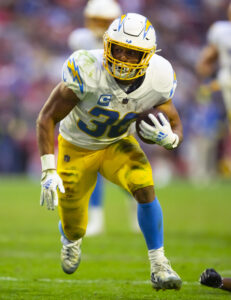 Ekeler lobbied for a new deal and was granted permission to seek a trade when it became clear no extension was coming. Despite Ekeler being tied to a mid-market deal (four years, $24.25MM), not much interest is believed to have developed. Ekeler, 29, then played out the contract and did not fare especially well.
Ekeler lobbied for a new deal and was granted permission to seek a trade when it became clear no extension was coming. Despite Ekeler being tied to a mid-market deal (four years, $24.25MM), not much interest is believed to have developed. Ekeler, 29, then played out the contract and did not fare especially well.
After leading the NFL in touchdowns in 2021 and ’22, Ekeler averaged a career-low 3.5 yards per carry and totaled 1,064 scrimmage yards. The versatile back suffered an early-season high ankle sprain. Saquon Barkley joined Ekeler in sustaining a high ankle sprain in September; the Giants RB landed a much better free agency deal (three years, $37.75MM) compared to the Chargers talent.
The Commanders added Ekeler on a two-year, $8.43MM deal. In terms of guarantees at signing, Ekeler surprisingly checked in eighth ($4.21MM) among free agent backs this year. As teams (the Chargers among them) reevaluated their RB positions over the past several years, three-down players have been prioritized. Ekeler’s pass-oriented skillset, which produced a 993-yard receiving season (2019) and two more 600-plus-yard aerial years, did not end up doing him any favors on a third contract. Not known for a hardnosed between-the-tackles style, Ekeler will attempt to bounce back in Washington as the Chargers pivot to cheaper players who offer better inside skills.
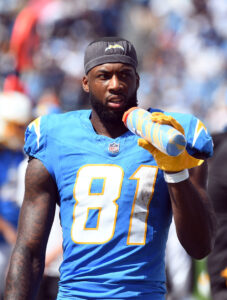 Injuries impeded Williams during much of his Chargers career, though he only missed a significant portion of the schedule last season. Williams’ Week 3 ACL tear brought challenges in a Chargers season that skidded off the rails, and Williams’ absence — after suffering a back fracture in a meaningless Week 18 game in Denver — in the infamous wild-card game in Jacksonville impacted the visitors in a 27-point collapse.
Injuries impeded Williams during much of his Chargers career, though he only missed a significant portion of the schedule last season. Williams’ Week 3 ACL tear brought challenges in a Chargers season that skidded off the rails, and Williams’ absence — after suffering a back fracture in a meaningless Week 18 game in Denver — in the infamous wild-card game in Jacksonville impacted the visitors in a 27-point collapse.
Telesco backed Staley’s decision to play starters in that Week 18 matchup against the Broncos, which did not impact the Chargers’ seed. Weeks into the new regime’s tenure, Williams became the first cap-clearing domino to fall.
Leading the NFL in yards per catch in Rivers’ final Bolts season, Williams served as Herbert’s top long-range option. The Chargers gave the former first-rounder a more multidimensional role in 2021, when he totaled a career-high 1,146 yards. Not as dependable as Allen, Williams will be difficult to replace but had become too pricey — particularly with the 2023 restructure ballooning his 2024 cap hit to $32MM — after two straight injury-marred seasons.
Linsley intends to retire, leaving the game after 10 seasons. An All-Pro in his final Packers season and Pro Bowler in his 2021 Chargers debut, the former fifth-round pick played three seasons on a then-center-record contract (five years, $62.5MM). A non-emergent heart issue shut down Linsley after three games last season, stalling a dependable run with the Bolts. Linsley, who started 99 games with the Packers from 2014-20, did not give up a sack in 33 games as a Charger.
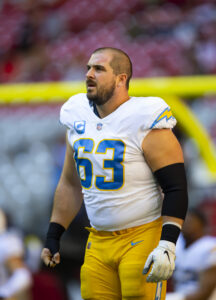 The team is also saving money at tight end, adding to the questions at the skill positions ahead of training camp. Everett delivered midlevel work on his midlevel contract, averaging just 8.1 yards per reception last season — a step down from his 555-yard 2022 showing. The Bolts added less proven receiving TEs — Hayden Hurst, Will Dissly — and spent all of $1MM in combined guaranteed money.
The team is also saving money at tight end, adding to the questions at the skill positions ahead of training camp. Everett delivered midlevel work on his midlevel contract, averaging just 8.1 yards per reception last season — a step down from his 555-yard 2022 showing. The Bolts added less proven receiving TEs — Hayden Hurst, Will Dissly — and spent all of $1MM in combined guaranteed money.
Dissly has excelled as a run blocker, while Hurst has been more effective as a receiver. The former first-round pick does have a 571-yard season (with the 2020 Falcons) on his resume but was struggling before sustaining a season-ending concussion. Receiving a post-traumatic amnesia diagnosis, Hurst had said he would have been ready to play before the season ended, only being shut down due to the Panthers’ season being lost.
Unsurprisingly, the Harbaugh-Hortiz regime passed on paying Murray. The 2020 first-rounder did not live up to his draft slot, being benched in 2021 and grading as a bottom-10 linebacker (per PFF) in 2022 and ’23. Murray did return to a full-time role last season, with he and Kendricks — made a cap casualty for a second straight offseason — being the team’s three-down linebackers. The Titans still see upside in Murray, giving him a two-year, $15.5MM contract.
Draft:
- Round 1, No. 5: Joe Alt (T, Notre Dame) (signed)
- Round 2, No. 34 (via Patriots): Ladd McConkey (WR, Georgia) (signed)
- Round 3, No. 69: Junior Colson (LB, Michigan) (signed)
- Round 4, No. 105: Justin Eboigbe (DL, Alabama) (signed)
- Round 4, No. 137 (from Chargers): Tarheeb Still (CB, Maryland) (signed)
- Round 5, No. 140: Cam Hart (CB, Notre Dame) (signed)
- Round 6, No. 181: Kimani Vidal (RB, Troy) (signed)
- Round 7, No. 225: Brenden Rice (WR, USC) (signed)
- Round 7, No. 253: Cornelius Johnson (WR, Michigan) (signed)
The Williams release and Allen trade ended a seven-season partnership and opened a gaping hole at wide receiver, but Harbaugh laid breadcrumbs about the team going in a different direction. Considering Roman’s presence and comment about a true commitment to the run game, the Bolts passing on Nabers at No. 5 was not too surprising.
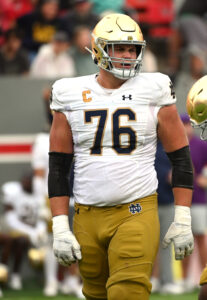 The Chargers held discussions on the No. 5 pick and were mentioned as eager to trade down. But Drake Maye looked to be the driver of notable trade offers. The Giants and Vikings sent trade proposals to the Patriots headlined by 2025 first-round picks, but after New England took Maye, Arizona and Los Angeles did not look to receive comparable offers. This cut into the Chargers’ leverage, moving the team toward an O-line pick. While JC Latham noise emerged close to the draft, Alt had been rumored as Harbaugh’s preference well before the event.
The Chargers held discussions on the No. 5 pick and were mentioned as eager to trade down. But Drake Maye looked to be the driver of notable trade offers. The Giants and Vikings sent trade proposals to the Patriots headlined by 2025 first-round picks, but after New England took Maye, Arizona and Los Angeles did not look to receive comparable offers. This cut into the Chargers’ leverage, moving the team toward an O-line pick. While JC Latham noise emerged close to the draft, Alt had been rumored as Harbaugh’s preference well before the event.
Going with Alt as the highest-drafted O-lineman since Russ Washington in 1968, the Chargers are moving the career-long Notre Dame left tackle to the right side. This will pair Alt and Pro Bowler Rashawn Slater, giving the team three first-round O-linemen — along with guard Zion Johnson — up front. The team is set to have just one new starter up front in 2024 (Alt), but the player he will displace at right tackle — Trey Pipkins — is shifting to right guard. Pipkins has never taken an NFL snap at guard, but Harbaugh’s “best five” approach is in motion.
Notre Dame left tackles Zack Martin and Mike McGlinchey converted to new positions as rookies. Alt will follow McGlinchey by changing tackle spots, as Slater has proven effective in his three-year L.A. run. Alt should bring a high floor to the Bolts, having earned first-team All-American honors in two straight seasons. Forty years after the Chiefs chose Alt’s father — John — in the first round, his son will also become an immediate AFC West starter. Anything short of the Chargers rostering a top-shelf tackle duo will be a disappointment.
 The team circled back to its receiver need to start Day 2, trading up three spots (via the Patriots) for McConkey. While the Chargers could conceivably bring the slot player along slowly due to the presences of Palmer, Johnston and Chark, it should be expected the 6-foot target will be a key part of the 2024 Bolts’ attack.
The team circled back to its receiver need to start Day 2, trading up three spots (via the Patriots) for McConkey. While the Chargers could conceivably bring the slot player along slowly due to the presences of Palmer, Johnston and Chark, it should be expected the 6-foot target will be a key part of the 2024 Bolts’ attack.
Back and ankle injuries limited McConkey in 2023, after he accumulated 762 receiving yards in 2022. He still averaged a career-best 15.9 yards per catch last season. McConkey improved his draft stock by blazing to a 4.39-second 40-yard dash at the Combine. Palmer has proven capable in the slot and has some experience outside, but the former third-round pick is in a contract year. Johnston did not show much as a rookie, which should keep Palmer as a vital presence. As a Harbaugh pick, McConkey is in place to be a potential long-term Palmer successor.
Although the Chargers had no need for J.J. McCarthy, Harbaugh could not resist reuniting with two of his former Michigan charges. The departures of Murray and Kendricks point to an early role for Colson, who is in a unique position of following both his HC and DC to the pros. Colson earned second-team All-Big Ten acclaim in 2022 and ’23. As of now, a Perryman-dependent Bolts LB group looks to have a three-down slot available for Colson.
Other:
- Rebuffed Patriots, Vikings’ trade inquiries into QB Justin Herbert
- Picked up LT Rashawn Slater‘s $19MM fifth-year option
- Signed 21 undrafted free agents
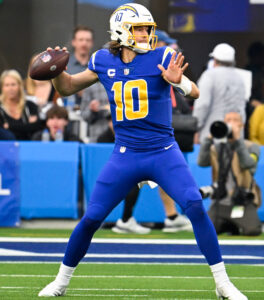 Blockbuster trades involving promising young quarterbacks have occurred. Deshaun Watson represents one case, Jay Cutler another. Those QBs’ situations had deteriorated to varying degrees; the Chargers seriously considering moving Herbert would have been far more stunning. The former Pro Bowl starter attracted Harbaugh’s interest, pulling him back to the NFL, and has shown himself to be one of the game’s most talented throwers.
Blockbuster trades involving promising young quarterbacks have occurred. Deshaun Watson represents one case, Jay Cutler another. Those QBs’ situations had deteriorated to varying degrees; the Chargers seriously considering moving Herbert would have been far more stunning. The former Pro Bowl starter attracted Harbaugh’s interest, pulling him back to the NFL, and has shown himself to be one of the game’s most talented throwers.
Like Rivers, Herbert has been at the controls for some agonizing losses. Harbaugh will be asked to address this franchise-defining problem, with the star QB — who is signed through 2029 — at the root of the solution effort.
Herbert’s left tackle is now signed for two more seasons. The Chargers said goodbye to a few mainstays on offense this offseason and cut costs at a few positions, but Slater should be expected to land in extension rumors in the near future. Andrew Thomas‘ $23.5MM-per-year Giants deal, which came in his first offseason of eligibility, would stand to provide a roadmap. Slater earning a second Pro Bowl nod and doing so under Harbaugh would up his price, as the cap has spiked and fellow 2021 first-rounder Penei Sewell reset the tackle market ($28MM AAV, $85MM guaranteed) in April.
Top 10 cap charges for 2024:
- Joey Bosa, OLB: $26.11MM
- Khalil Mack, OLB: $25.4MM
- Derwin James, S: $19.86MM
- Justin Herbert, QB: $19.35MM
- Trey Pipkins, OL: $8.75MM
- Joe Alt, RT: $6.03MM
- Rashawn Slater, LT: $5.29MM
- Morgan Fox, DL: $4.75MM
- Zion Johnson, G: $4.02MM
- Asante Samuel Jr., CB: $4.02MM
The Chargers made the playoffs just twice in Rivers’ final 10 seasons with the team; they are 1-for-4 with Herbert at the helm. Harbaugh will be tasked with turning an era-defining tide. Harbaugh’s return spices up an AFC West that includes the two-time reigning champions and Sean Payton. In Harbaugh and Herbert, the Bolts have a fascinating combo in place to rebuild this operation. The team that had been viewed as the top Chiefs divisional deterrent for several years fell flat too often despite well-regarded rosters. Harbaugh will put his historic NFL win percentage on the line aiming to bring his quirky but successful M.O. back to the pros.